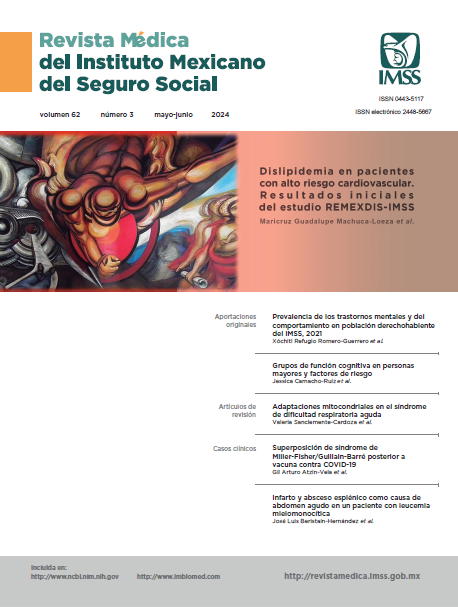Health literacy and its association with the control of hypertension
Main Article Content
Keywords
Hypertension, Health Education, Health Literacy
Abstract
Background: Health literacy (HL) involves self-care skills of healthy people and those with chronic diseases.
Objective: To assess the association between HL and blood pressure (BP) control in patients with hypertension.
Material and methods: A cross-sectional survey was conducted from April to June 2022 in a family medicine unit from the Mexican Institute for Social Security (IMSS). This survey included 349 adults of 18 years of age or older with hypertension diagnosis and antihypertensive pharmacological treatment. HL was measured with the European Health Literacy Survey HLS-EU-Q12M, validated in Mexico. The characteristics of participants with and without BP control were compared with chi-square. Multiple Poisson regression was applied to assess the association between HL and BP control, and it was controlled based on the clinically important covariates.
Results: 60.2% of patients with hypertension had BP controlled; 23.8% had inadequate HL, 44.4% problematic HL, and 31.8% sufficient HL. Sufficient HL was associated with BP control only in patients with high school or higher education (adjusted prevalence ratio 2.18, 95% confidence interval 1.16-4.08).
Conclusions: Only 60% of hypertensive patients achieve control of their BP. Sufficient HL is associated with greater likelihood of BP control in patients with high school or higher education.
References
Sorensen K, Van den Broucke S, Fullam J, et al. Health literacy and public health: a systematic review and integration of definitions and models. BMC Public Health. 2012;12:(1). doi: 10.1186/1471-2458-12-80.
Organización Mundial de la Salud. Carta de Otawa para la promoción a la salud. Otawa, Canadá: OMS; 1986.
Nolasco A, Barona C, Tamayo N, et al. Alfabetización en salud: propiedades psicométricas del cuestionario HLS-EU- Q16. Gac Sanit. 2020;34(4):399-402. doi: 10.1016/j.gaceta.2018.08.006.
Emiral G, Aygar H, Isiktekin B, et al. Health literacy scale-European unión- Q16: a validity and reliability study in Turkey. Int Res J Medical Sci. 2018;6(1):1-7.
Gustafsdottir S, Sigurdardottir A, Arnadottir S, et al. Translation and cross-cultural adaptation of the European Health Literacy Survey Questionnaire, HLS-EU-Q16: the Icelandic version. BMC Public Health. 2020;20(1):61. doi: 10.1186/s12889-020-8162-6.
Du S, Zhou Y, Fu C, et al. Health literacy and health outcomes in hypertension: An integrative review. Int J Nurs Sci. 2018;5:301-9. doi: 10.1016/j.ijnss.2018.06.001.
Berkman N, Sheridan S, Donahue K, et al. Low health literacy and health outcomes: an updated systematic review. Ann Intern Med. 2011;155(2):97-107. doi: 10.7326/0003-4819-155-2-201107190-00005.
Davis T, Wolf M. Health Literacy: Implications for Family Medicine. Fam Med. 2004;36(8):595-8.
Campos-Nonato I, Oviedo-Solís C, Vargas-Meza J, et al. Prevalencia, tratamiento y control de la hipertensión arterial en adultos mexicanos: resultados de la Ensanut 2022. Salud Publica Mex. 2023;65(1):S169-80. doi: 10.21149/14779.
Nutbeam D. Health literacy as a public health goal: a challenge for contemporary health education and communication strategies into the 21st century. Health Promot Int. 2000;15:259-67. doi: 10.1093/heapro/15.3.259.
Pandit A, Tang J, Cooper S, et. al. Education, literacy, and health: Mediating effects on hypertension knowledge and control. Patient Educ Couns. 2009;75(3):381-5. doi: 10.1016/j.pec.2009.04.006.
Costa V, Costa P, Nakano E, et al. Functional health literacy in hypertensive elders at primary health care. Rev Bras Enferm. 2019;72(2):266-73. doi: 10.1590/0034-7167-2018-0897.
Hall E, Lee S, Clark P, et al. Social ecology of adherence to hypertension treatment in latino migrant and seasonal farmworkers. J Transcult Nurs. 2016;27(1):33-41. doi: 10.1177/1043659614524788.
Ko Y, Devi T, Wong L, et al. Health literacy and its association with disease knowledge and control in patients with hypertension in Singapore. Int J Cardiol. 2013;168(4):e116-7. doi: 10.1016/j.ijcard.2013.08.041.
García Vera EM, Doubova SV, Sánchez Arenas R, et al. Validación de la escala de alfabetización en salud en pacientes con hipertensión en México. Gac Med Mex. 2023;159(4):329-37. doi: 10.24875/GMM.23000118.
Sorensen K, Van den Broucke S, Pelikan JM, et al. Measuring health literacy in populations: illuminating the design and development process of the European Health Literacy Survey Questionnaire (HLS-EU-Q). BMC Public Health. 2013;13:948. doi: 10.1186/1471-2458-13-948.
Röthlin F, Pelikan J, Ganahl K. Die Gesundheitskompetenz von 15-jährigen Jugendlichen in Österreich. Abschlussbericht der österreichischen Gesundheitskompetenz Jugendstudie im Auftrag des Hauptverbands der österreichischen Sozialversicherungsträger (HVSV). Wien, Austria: Ludwig Boltzmann Gesellschaft GmbH, Ludwig Boltzmann Institut Health Promotion Research (LBIHPR); 2013.
Doubova SV, Lamadrid-Figueroa H, Pérez-Cuevas R. Use of electronic health records to evaluate the quality of care for hypertensive patients in Mexican family medicine clinics. J Hypertens. 2013;31(8):1714-23. doi: 10.1097/HJH.0b013e3283613090.
Promoción, Prevención, Diagnóstico y Tratamiento de la Hipertensión Arterial en Primer Nivel de Atención. Guía de Práctica Clínica: Evidencias y Recomendaciones. México, CENETEC; 2021. Disponible en: http://www.cenetec-difusion.com/CMGPC/GPC-IMSS-076-21/ER.pdf.
Márquez E. Evaluación del incumplimiento en la práctica clínica. Hipertensión. 2008; 25(5):205-13. doi: 10.1016/S0212-8241(08)75980-2.
Wilson-VanVoorhis C, Morgan BL. Understanding power and rules of thumb for determining sample sizes. Tutor Quant Methods Psychol. 2007;3(2):43-50. doi: 10.20982/tqmp.03.2.p043.
Barros A, Hirakata A. Alternatives for logistic regression in cross-sectional studies: an empirical comparison of models that directly estimate the prevalence ratio. BMC Med Res Methodol. 2003;3(1). doi: 10.1186/1471-2288-3-21.
Parody Rua E, Vásquez Vera AF. Prevalencia y factores asociados a la adherencia en un centro de atención primaria de Cali: comparación de 3 test de adherencia. Pharm Care Esp. 2019;21(1):23-40.
Castañeda-Sánchez O, López del Castillo-Sánchez D, Araujo-López A. Apego farmacológico en pacientes con hipertensión arterial de una Unidad de Medicina Familiar de Ciudad Obregón, Sonora (México). Arch Med Fam. 2008;10(1):3-6.
Peña-Valenzuela AN, Ruiz-Cervantes W, Barrios-Olán C. Relación médico-paciente y adherencia terapéutica en pacientes con hipertensión arterial. Rev Med Inst Mex Seguro Soc. 2023;61(1):55-60. Disponible en: https://www.ncbi.nlm.nih.gov/pmc/articles/PMC10396067/
Rouquette A, Nadot T, Labitrie P, et al. Validity and measurement invariance across sex, age, and education level of the French short versions of the European Health Literacy Survey Questionnaire. PLoS ONE. 2018;13(12):e0208091. doi: 10.1371/journal.pone.0208091.
Jardim TV, Souza A, Barroso W, et al. Blood pressure control and associated factors in a real-world team-based care center. Arq Bras Cardiol. 2020;115(2):174-81. doi: 10.36660/abc.20180384.
Rodríguez M, García E, Amariles P, et al. Revisión de tests de medición del cumplimiento terapéutico utilizados en la práctica clínica. Aten Primaria. 2008;40(8):413-7. doi: 10.1157/13125407.


